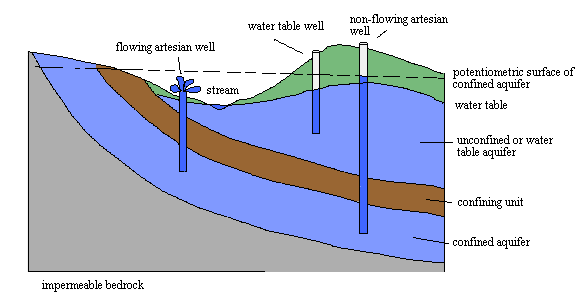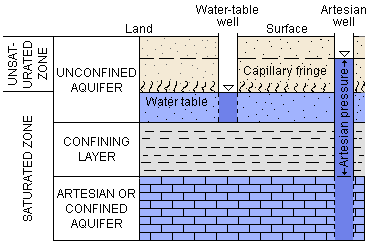


Aquifer is the term given to a rock unit that will yield water in usable quantities to wells or springs. An aquifer can be visualized as a giant underground sponge which holds water and which, under certain conditions, will allow water to move through it. Depending on the type, the aquifer may contain both the saturated and unsaturated zones, or just the saturated zone.
The water-bearing rocks that compose aquifers consist either of unconsolidated (soil-like) deposits or consolidated rocks. Most consolidated rocks (otherwise known as bedrock) consist of rock and mineral particles of different sizes and shapes that have been welded together by heat and pressure or chemical reaction into a rock mass. Aquifers of this type are commonly composed of one or more of the following rocks: sandstone, limestone, granite, or lava. Water flows through these rocks through fractures, gas pores, and other openings in the rock.
Most unconsolidated materials consist of material derived from the disintegration of consolidated rocks. Unconsolidated deposits include, in different types of unconsolidated deposits, some or all of the following materials in varying combinations: soil-like materials, gravel, sand, silt, clay, and the fragments of shells of marine organisms. Sand dunes and gravel piles are examples of unconsolidated material. Water flows through these materials through the natural openings between particles.

The physical properties of aquifer materials and of the aquifers themselves (i.e., thickness, depth) are important in determining how quickly ground water will move and what routes it will take as it moves through an aquifer. This knowledge helps decide how best to get water out of the ground for drinking water, irrigation, and other uses. These same properties are important in defining how contaminants originating on the surface will flow in the aquifer and in determining an appropriate cleanup remedy if the aquifer becomes contaminated.
Aquifers are generally classified as one of the following:
While aquifers can be thought of simply as unconfined or confined for educational purposes, in nature, most of the world's ground water occurs in far more complex hydrogeological systems that can radically impact the movement of ground water. These systems might contain multiple overlying confined and unconfined aquifers, partially permeable or laterally incomplete confining beds, perched water tables, intersecting lakes and streams, intrusions of rock such as granitic domes, faulting, etc. Understanding these complexities is critical to designing adequate drinking water supplies and selecting appropriate remedies for cleaning up contamination.
| © Copyright |